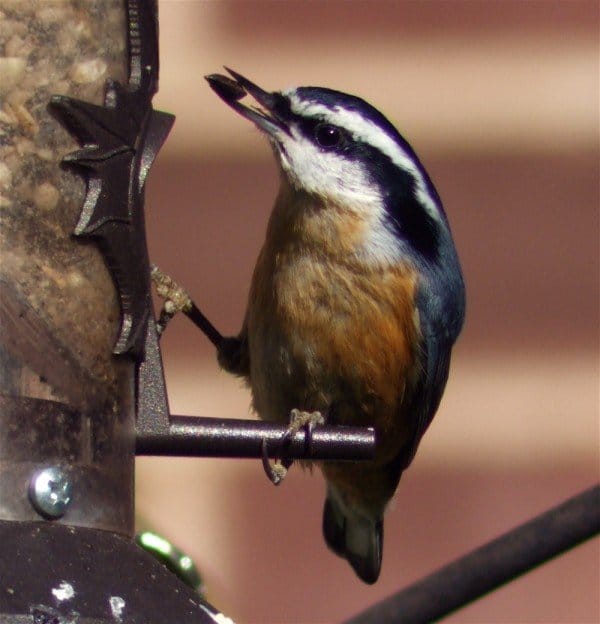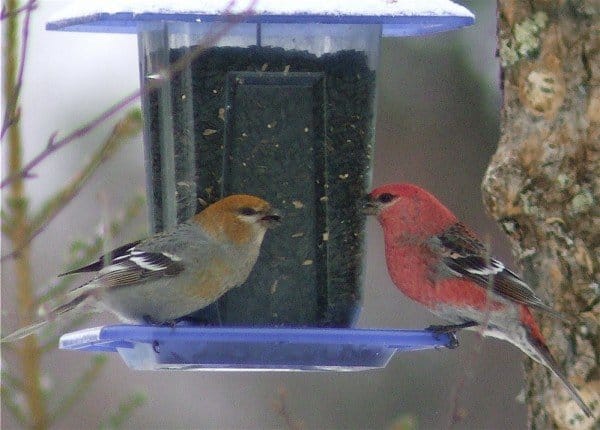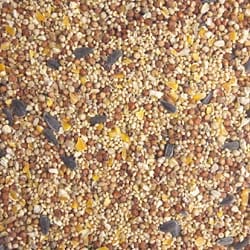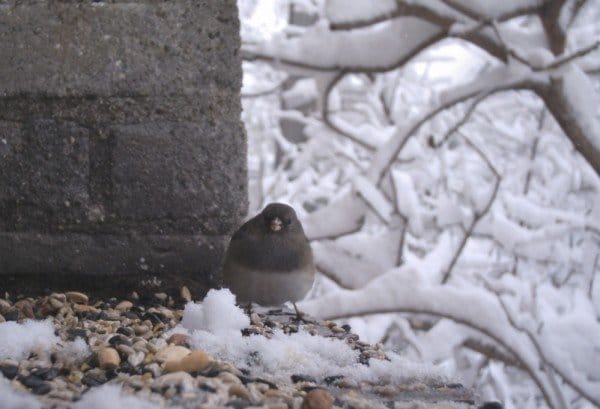Two common questions I get this time of year is 1. when do I start feeding birds and 2. what should I feed?
First, unless you are talking hummingbirds and orioles just feed birds when you are in the mood to watch them and can afford it. There are always cool bird to be seen. Though some species are shedding breeding plumage and taking on more somber winter colors, they’re still often cute as button.
As more companies carry bird seed and wild bird stores add blends, how can you tell what’s the best for you when attracting birds like the above Red-breasted Nuthatch? Though there are some regional variations, there are a few rules of thumb that can help you pick a good seed…or look at a hardware store’s selection and wisely decide to avoid it.
Note the color of the bird seed in the feeder these Pine Grosbeaks are using. It’s all black, full of black oil sunflower seed. If you are only going to use one seed, this is the one that seems to get the most variety of birds. If a bird eats a seed, most likely it will eat sunflower seeds. Northern Cardinals love this as do Green Jays, chickadees, nuthatches–even tiny goldfinches. Often, just purchasing plain black oil sunflower is cheaper than a mix, depending on where you shop. You really cannot go wrong with that seed…unless it’s really old. Often around November, some places like big box stores or hardware stores will have a sunflower seed that’s half the price of everywhere else. It can even be a little cheaper than wholesale cost for most bird stores. Why is that? Most likely, the seed is a of couple years old and no one else will carry it in their stores because the nut meat is not as desirable to birds (and chock full of meal moth larvae). You can read more about that here.
When people tell me they that they have bird seed but few birds, I start by asking what color the mix looks like. Is it mostly yellow or mostly black?
If it’s mostly yellow and orange like the above photo, it’s not going to be a desirable mix for most birds–apart from quail, pheasants, turkeys and House Sparrows. That mix has a lot of white millet and milo and very few sunflowers. It makes for an inexpensive mix but probably won’t get you cardinals, chickadees and nuthatches. You can do one of 2 things. Buy some sunflower and mix it in or dump it all out side and purchase a sunflower heavy mix.
A little millet is okay, some birds like Dark-eyed Juncos (above) and native sparrows like Fox Sparrows, White-throated and White-crowned Sparrows like it. But no need to go overboard.
So, for picking a basic mix, go for mostly sunflower, avoid too much millet. If you’re not sure, at least try to make sure the mix is mostly dark in color. Be wary of stores that sell seed and don’t have a way to show you want that mix looks like. Even if sunflower is listed as the fist ingredient on a mix, that doesn’t mean it’s the main ingredient. There’s no regulation on seed mix ingredients and packagers will play with seed ratios based on market prices when they blend the mixes. If you can’t see the mix, just by sunflower.















100% agree about black-oil sunflower seeds – easily the favorite food of all my backyard birds. Lazuli Buntings are also millet lovers, along with the winter sparrows! Nyger for the Goldfinch and Siskins. Shelled peanuts are enjoyed by a wide variety and in-shell peanuts are fun for the jays.
True about black Oil Sunflower seeds but then such a mess, right? Thanks for the tip about the millet…..now if I can only get rid of those bully Blue Jays…